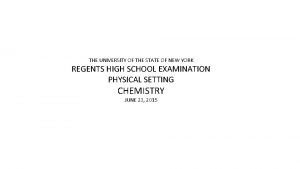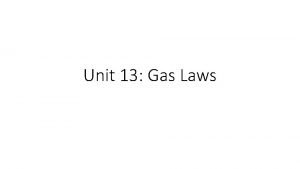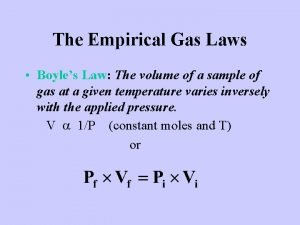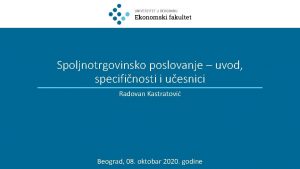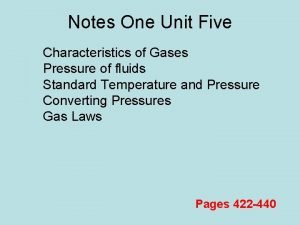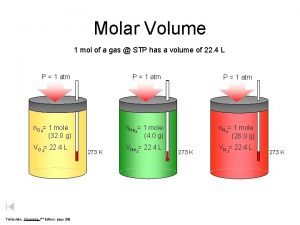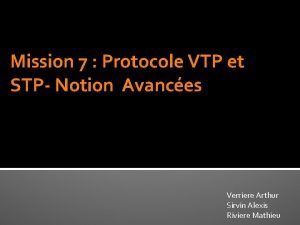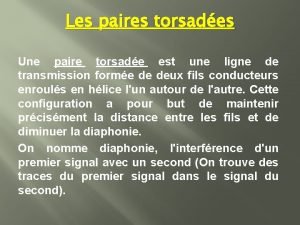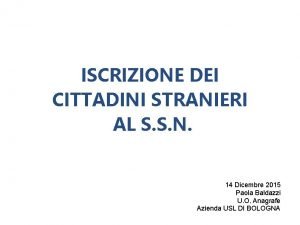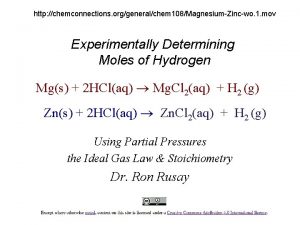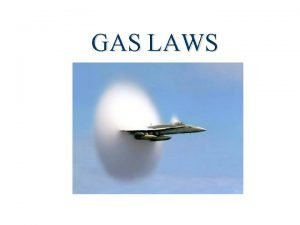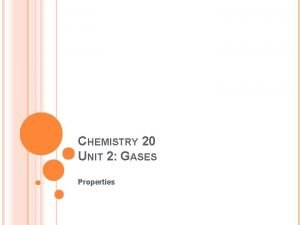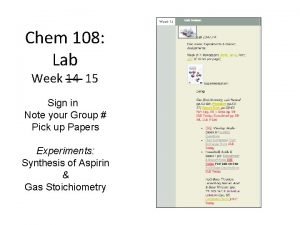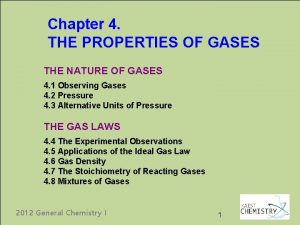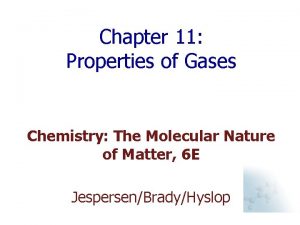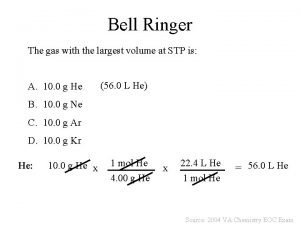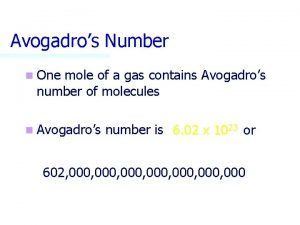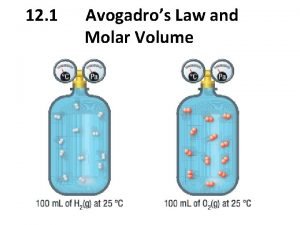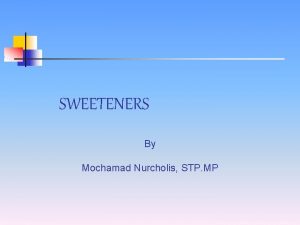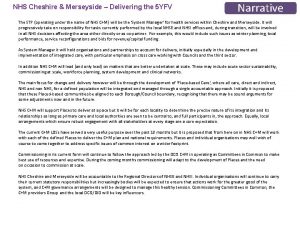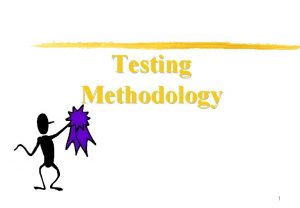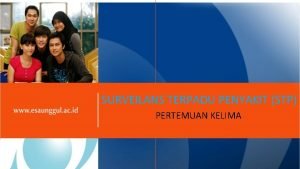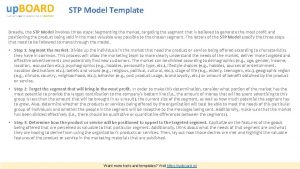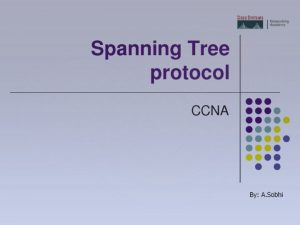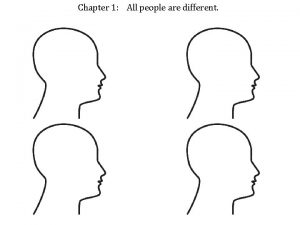STP Has a Different Meaning to Different People









































- Slides: 41

STP Has a Different Meaning to Different People 16 th Annual RETS/REMP Workshop 26 -28 June 2006 Mashantucket, CT By Frank M. Gavila

Overview 1. 2. 3. 4. 5. 6. Introduction to Ideal Gas Laws Concept of reference temperature and pressure for comparison of two different gas volumes or two different flowrates Definitions of various recognized reference to T and P’s How does REMP or RETS air sampling activities get involved with reference T and P issues? Regulatory references or standards Solutions

Introduction to the Ideal Gas Laws 1. Introduction to the Ideal Gas Laws I. Gas Law Basics A. Gases n n n In the gas phase, molecules are relatively far apart. This makes gases very compressible. A gas expands to fill the volume of its container. Gases are usually measured by volume so a relationship between volume and number of moles is needed.

Introduction to the Ideal Gas Laws (cont. ) B. The Gas Laws n n The gas laws are experimental relationships among pressure (P), volume (V), temperature (T) and moles (n). - Boyle’s Law (V, P) - Charle’s Law (V, T) - Avogadro’s Law (V, n) - Ideal Gas Law (V, P, T, n) All gases behave similarly. The gas laws assume ideal behavior.

Introduction to the Ideal Gas Laws (cont. ) C. Boyle’s Law In 1662, Robert Boyle discovered that volume is inversely proportional to pressure V ∞ 1 (constant T, n) P

Atmospheric pressure Gas Volume – 60 m. L Volume – 30 m. L 760 mm Hg added

Introduction to the Ideal Gas Laws (cont. ) D. Charles’ Law Lord Kelvin proposed an absolute temperature scale defined by T(K) = T(C)+273. 15 Expressed in absolute temperature, Charles’ law is: V ∞ T (constant P, n) Charles discovered that volume is directly proportional to temperature. The volume of a gas extrapolates to zero at -273 o. C. This must be the lowest temperature possible.

Introduction to the Ideal Gas Laws (cont. )

Introduction to the Ideal Gas Laws (cont. ) E. Avogadro’s Law In 1811, Avogadro proposed that: Equal volumes of gases at the same temperature and pressure contain equal numbers of molecules. It follows that the volume of a gas at constant temperature and pressure is proportional to the number of moles. V ∞ n (constant T, P)

Introduction to the Ideal Gas Laws (cont. ) F. The Ideal Gas Equation Combining the gas laws gives: V ∞ n. T P or V=R n. T P Where R is called the Gas constant: R = 0. 08206 L. atm mol. K The Ideal gas law is usually written as: PV = n. RT

Introduction to the Ideal Gas Laws (cont. ) Processes Involving Ideal Gases Let’s describe a process by which an ideal gas is transferred from conditions at State 1 to conditions at State 2 (Actual Conditions) or: State 1 P 1, V 1, n 1, T 1 State 1: P 1 V 1 = n 1 RT 1 State 2 (Reference Conditions) P 2, V 2, n 2, T 2 State 2: P 2 V 2 = n 2 RT 2

Introduction to the Ideal Gas Laws (cont. ) Solving for R: R= P 1 V 1 n 1 T 1 = P 2 V 2 n 2 T 2 If the number of moles stays constant (n 1 = n 2) P 2 V 2 = P 1 V 1 T 2 T 1 or P Ref . VRef = PACT. VACT T Ref TACT

Introduction to the Ideal Gas Laws (cont. ) Thus VREF = VACT PACT. TRef PRef TACT

Introduction to the Ideal Gas Laws (cont. ) 2. Concept of Reference Temperature and Pressure In order to compare the volumes of the same gas or the corresponding gas flowrate (volume/unit time) of two different gas samples, it is necessary to ensure that the T and P are the same for both gas volumes or flowrates. This results in the ideal gas law equation V = n RT = n. k P

Introduction to the Ideal Gas Laws (cont. ) Therefore, the volume of the gas is only a function of the number of moles of gas present in each of the two different samples collected assuming the pressure and temperature are the same. It is erroneous to compare two different volumes of the same gas without comparing these volumes at the same reference temperature and pressure. The same applies to flowrates (volume/unit time).

Introduction to the Ideal Gas Laws (cont. ) 3. Commonly Utilized Reference T and P for Testing and Documentation of Chemical and Physical Processes A. Standard Temperature and Pressure (Classical) STP – Standard Temperature and Pressure is defined as air at: T = 0 o. C (273. 15 o. K) or 32 o. F (460 o. R) P = 1 Atmosphere (atm) or 760 torr, 14. 7 psia, 29. 92 in. Hg, 101. 325 k. Pa Approximate freezing point of water and atmospheric pressure at sea level.

Introduction to the Ideal Gas Laws (cont. ) B. Normal Temperature and Pressure NTP – Normal Temperature and Pressure is defined as air at: T= 20 o. C (293. 15 o. K), 68 o. F P = 1 atm. 14. 7 psia, 760 mm Hg, 29. 92 in Hg, 101. 325 k. Pa NTP is common for testing and documentation of fan capacities

Introduction to the Ideal Gas Laws (cont. ) C. Standard Ambient Temperature and Pressure SATP – Standard Ambient Temperature and Pressure is defined as air at: T = 25 o. C (298. 15 o. K), 77 o. F P = 101 k. Pa (1 atm. ) The temperature and pressure where the equilibrium constant for the auto ionization of water is 1. 0 x 10 -14

Introduction to the Ideal Gas Laws (cont. ) D. International Standard Atmosphere ISA - International Standard Atmosphere is defined as air at sea level where: T = 15 o. C (59 o. F) P = 101. 325 k. Pa, 1 atm. RH = 0% ISA is utilized a a reference for aircraft performance figures such as endurance, range, airspeed and fuel consumption.

Introduction to the Ideal Gas Laws (cont. ) E. Army Standard Metro Atmosphere ASM – Army Standard Metro atmosphere is defined as sea level conditions of: T = 15 o. C (59 o. F) P = 750 mm Hg (29. 5275 in Hg) RH = 78% Utilized only for ballistics US Army Ballistic Research Laboratory Aberdeen Proving Ground

Introduction to the Ideal Gas Laws (cont. ) F. Modified Normal Temperature and Pressure (USA only) T = 70 o. F (21. 1 o. C) P = 1 atm. ; 29. 92 in. Hg, 760 mm Hg

Introduction to the Ideal Gas Laws (cont. ) G. Mass Flow Reference Conditions The mass flow of a gas is defined as the rate at which mass crosses an imaginary cross-sectional area in a conduit. Typical units for mass flow can be: • Grams per minute or kilograms per hour • Pounds per second or pounds per hour

Introduction to the Ideal Gas Laws (cont. ) True Mass Flow (M) can also be obtained by measurement of volumetric flow at any T and P and converting the volumetric flow to the refernce classical STP conditions of 0 o. C and 1 atm and multiplying by the gas density of classical STP. This is represented by the following formula:

Introduction to the Ideal Gas Laws (cont. ) True Mass Flow (M) = Q. Ts. Pa. ρg = Mv. ρg Ta Ps Where Q = Volumetric flowrate at actual T and P conditions Ts = Absolute T @ standard condition in Kelvin (273. 15 o. K) Ta = Absolute T @ flow condition in Kelvin Ps = Absolute pressure at standard conditions (1 atm) Pa = Absolute pressure at flow conditions ρg = Density of gas at classical STP conditions ( 0 o. C, 1 atm)

Introduction to the Ideal Gas Laws (cont. ) To convert to mass flow (Mv) in volumetric units from flow at actual conditions use the following formula: Mv = Q. Ts. Pa Ta Ps Where Mv = Mass flow in volumetric units at STP (0 o. C, 1 atm) The density of various gases at STP is presented on the next slide.

Density of Gases at STP (0 o. C, 1 ATM) Gas Air, dry Ammonia Carbon dioxide Carbon monoxide Chlorine Dinitrogen monoxide Ethyne (acetylene) Helium Hydrogen Density (g/L) 1. 2929 0. 771 1. 977 1. 250 3. 214 1. 977 1. 171 0. 1785 0. 0899

Density of Gases at STP (0 o. C, 1 ATM) (cont. ) Gas Hydrogen chloride Methane Sulphur dioxide Nitrogen monoxide Oxygen Density (g/L) 1. 639 0. 7165 2. 927 0. 716 1. 251 1. 429

Introduction to the Ideal Gas Laws (cont. ) To compute True Mass Flow (M) multiply Mv by the density of the gas at 0 o. C, 1 atm. True Mass Flow (M) = Mv. ρg Mass flow sensors which are currently utilized for many airflow measurements are generally reporting volumetric flow values at 0 o. C, 1 atm (classical STP). These volumes can easily be corrected to any reference T and P utilizing the gas law formulas.

Introduction to the Ideal Gas Laws (cont. ) 4. The RETS/REMP air monitoring specialist gets involved with reference T and P issues simply by the fact he is making flow measurements for purposes of determining volumes of air passing through particulate and/or radioiodine collection cartridges over a duration of time (sample duration). He then integrates the volume measurements with radioactivity analysis in downstream calculations to determine radioactivity concentrations (radioactivity per unit volume).

Introduction to the Ideal Gas Laws (cont. ) The volume of the samples is determined by either by calculation of flowrate (measured by typically a rotameter) multiplied by elapsed sample time or by the difference between ending and beginning reading on a volume totalizer (such as a dry gas test meter). Some facilities employ volume totalizer systems that display the calculated volume corrected to a reference T and P.

Introduction to the Ideal Gas Laws (cont. ) It is evident that the temperature of the air sample is a function of the: Geographical location n Elevation n Season of year and n Time of day n

Introduction to the Ideal Gas Laws (cont. ) The absolute pressure of the air sample is a function of n the elevation n the short term local atmospheric weather conditions that influences the local barometric pressure n the pressure drop of the filter(s) utilized n the inherent sample system line losses attributing to pressure drop and n dust loading, if any.

Introduction to the Ideal Gas Laws (cont. ) The above expected variations in both T and P which a large number of users will experience at approximately 60 different plant sites in the USA will result in sample volume determinations that are not truly comparable with each other and thus any calculated results involvng these volumes are not in and of themselves comparable to each other. Of concern is that in the vast majority of cases, no data is being collected to enable a future correction of data even if such an adjustment were required after the sample event.

Solution The only way to ensure reliability of comparison of data between air monitoring results published by USA NPP is to report all measured or calculated volumes to a mutually agreed upon reference T and P. This will remove the data inconsistency due to geographical elevation, seasonal variations, uniqueness of sample systems, differences in pressure drop of filters utilized, local dust loading, etc.

Solution What should be the Reference T and P? Four good options are: n STP n SATP n NPT n MNPT

Solution Is there a precedent, regulatory guideline, or standard? ANSI/HPS N 13. 1 -1999 There is a recent precedent in ANSI/HPS N 13. 1 -1999 Section 3. 1. This ANSI Standard applies to emissions from nuclear power plant facilities such as stacks, ducts and other exit pathways. Standard Conditions: “Used to convert air densities to a common basis. The standard conditions adopted in this standard are a temperature of 25 o. C and a pressure of 760 mm Hg. ” These are the reference conditions for Standard Ambient Temperature and Pressure.

Recommendations to the RETS/REMP Organization 1. The RETS/REMP organization should consider its authority and responsibility to make an organizational decision to recommend that all NPP members correct measured or calculated volumes that are determined for air samples reported to any regulatory agency to a reference temperature and pressure definable by the RETS/REMP organization.

Recommendations to the RETS/REMP Organization (cont. ) 2. The RETS/REMP organization should determine and recommend an appropriate reasonable phase in time period of reporting corrected volumes in order to achieve uniformity of reported results that involve volume determinations.

Recommendations to the RETS/REMP Organization (cont. ) 3. The RETS/REMP organization should recommend the selection of SATP in order to maintain consistency with ANSI/HPS N 13. 1 -1999 that applies to the NPP community.

Recommendations to the RETS/REMP Organization (cont. ) 4. The RETS/REMP organization should notify the USNRC of the official position that the RETS/REMP organization is taking and request that they provide within 90 days a comment letter indicating any adverse consequences they see in implementing the new volume reporting strategy for purposes of achieving consistency among all NPP. Additionally, the USNRC should comment as to whether any existing agency regulation, guideline or other document would prohibit the implementation of reporting volumes corrected to SATP (25 o. C, 1 atm) consistent with to that adopted by ANSI/HPS 13. 1 -1999 that is applicable to emissions from NPP.

Conclusion The RETS/REMP organization has an opportunity to take a bold step forward and make a significant contribution to the uniformity of reported data and to implement a strategy that will provide for consistent reporting of sample volumes that are utilized to determine compliance with emission limits, source, term calculations or for comparison with data from other NPP worldwide.
 At stp, which substance has metallic bonding?
At stp, which substance has metallic bonding? We are all different but the same
We are all different but the same Utp ve stp kablo arasındaki fark
Utp ve stp kablo arasındaki fark Volume and pressure formula
Volume and pressure formula Radiology st1 competition ratio
Radiology st1 competition ratio What are the empirical gas laws
What are the empirical gas laws Spanning-tree bpdu-protection
Spanning-tree bpdu-protection Piaci rés fogalma
Piaci rés fogalma Stp ekof
Stp ekof Stp theory
Stp theory Pv nrt
Pv nrt Pressure cooker temperature chart
Pressure cooker temperature chart Stp temperature
Stp temperature Configuration vtp
Configuration vtp Differenciált marketing
Differenciált marketing Live happy live healthy
Live happy live healthy Stp temperature
Stp temperature Cable a paire torsadée
Cable a paire torsadée Stp theory
Stp theory Codice stp
Codice stp Standard conditions vs stp
Standard conditions vs stp Stp for gases
Stp for gases Gas laws
Gas laws Stp and satp
Stp and satp Stp conditions
Stp conditions Stp vs standard conditions
Stp vs standard conditions Stp and satp
Stp and satp Stp chemistry
Stp chemistry The gas with the largest volume at stp is -
The gas with the largest volume at stp is - Standard conditions vs stp
Standard conditions vs stp Toastmasters
Toastmasters Satp volume
Satp volume Stp marketing wiki
Stp marketing wiki Stp
Stp Stp marketing
Stp marketing Ada berapa banyak segmen prizm?
Ada berapa banyak segmen prizm? Plasticscore
Plasticscore Cheshire and merseyside stp
Cheshire and merseyside stp Market segmentation kotler
Market segmentation kotler Stp
Stp Brand mantra
Brand mantra Stp software test plan
Stp software test plan
